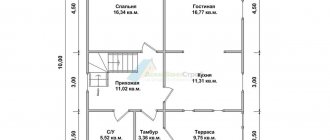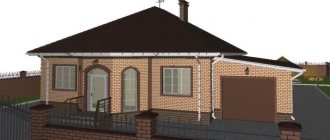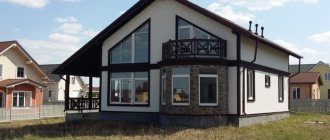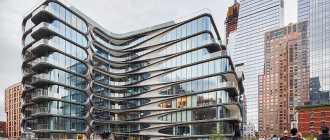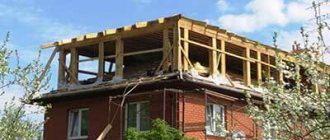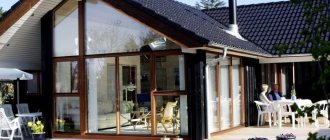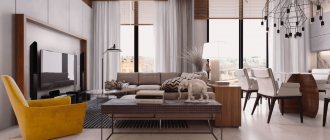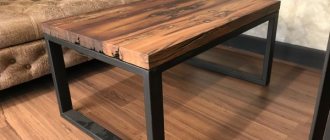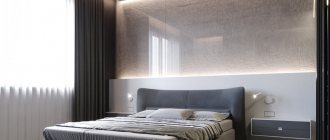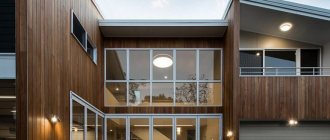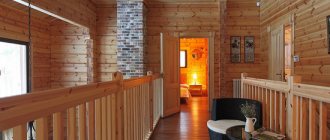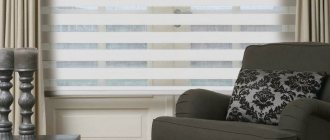No. 1. Classic style
Despite the emergence of many interesting modern architectural styles, the classic remains popular because it creates the impression of solidity and emphasizes the refined taste of the home owner. The style is suitable for large houses, and its main features are:
- symmetry and clarity of forms, regular layout, proportionality and harmony;
- Decorative elements are definitely present, but they are not very pretentious. Particular attention is paid to balustrades and columns;
- Mostly natural materials are used: plaster and marble for walls, natural tiles for roofing, forged metal for fences and gratings.
Japanese style
There are more and more fans of Japanese-style interiors every year. This design captivates with its lightness and simplicity; there is nothing superfluous in it. Guests who come to the house are always enthusiastic about such oriental solutions, which do not make you sad with their banality.
The main ideology of the interior, made in the Japanese style, is the simplicity of decoration. Being in such an atmosphere, a person can immerse himself in his thoughts or simply relax. Nothing distracts him and, at the same time, nothing bothers him.
A room or a whole house, made in Japanese style, is characterized primarily by spaciousness. There is no feeling of overload, which often causes an interior full of furniture and other interior decorations. At the same time, special attention is paid to the accuracy of the shapes of objects and their geometric harmony.
Various philosophical teachings of the East have had their special imprint on this style. According to them, each of us has our own inextricable connection with nature. This approach was reflected in the materials that are present in the space of Japanese rooms, as well as their color scheme.
Nature is a living organism, and therefore the room must have some mobility. Perhaps that is why the indispensable attributes of the Japanese style are all sorts of screens and partitions that can easily be transformed, moved or removed altogether.
Screens generally play a special role in the design of a Japanese home. They are very light, which makes them easy to move, thereby constantly changing the appearance of the rooms. In addition, they play a practical role - they divide the room into zones and allow a person to abstract from the rest of the space in the house, in which there may be other people.
Japanese screens, as a rule, are made only of wood. Their shape is either rectangular or square, which once again emphasizes the simplicity of this style.
In Japanese culture, the use of furniture familiar to Europeans is kept to a minimum. Basically, this is a low table, at which it is customary to sit on the floor, using special pillows, and a small sofa, also of low height. There are simply no wardrobes familiar to many Europeans here. They are replaced by niches that are located in the wall.
Light filling of space is very important for the Japanese. At the same time, they use ordinary lampshades, often made of paper, having the same simple, precise shapes: rectangle, prism, ball.
A variety of decorative interior additions help you immerse yourself in the atmosphere of a Japanese home and feel it. These include traditional Japanese characters on the walls, ornaments and patterns. The presence of boxes, vases, and sculptures is also welcome. As a rule, fans with images of samurai or sakura are hung on the walls.
The Japanese, as admirers of the surrounding nature, cannot do without the use of plants in their interiors. Moreover, they can be either living or dried, for example, “ikebana” or a “bonsai” tree.
Not everyone will understand a Japanese-style interior. Minimalism is inherent to people who are not used to rushing, who like to leisurely reflect and spend time in a calm environment.
Nowadays, decorating your home in an oriental style is not difficult. A private interior designer can help with this, who will design the house in a unique Japanese style.
Caring for a private home, cottage. Maintenance and operation problems
Paint for a children's room in the house. Which one is better to choose?
The procedure for assigning an address to a dacha, cottage, house and other real estate in the Moscow region
Preparing the site for a garden and lawn after construction
What should you consider when choosing a housekeeper (maid)?
Heat exchangers. What it is? And which ones to choose for your home?
Fuse disconnector for electrical panel. Which one is better to choose for your home?
Which fence to build at the dacha? How to build with your own hands?
Houses and cottages measuring 8 by 8 m. Pros and cons
How to insure yourself against fraud when buying a home in a new building?
No. 2. Baroque
The Baroque style is pretentiousness, pomp, and abundance of decor. The direction is not so often used in modern construction - usually only its individual features :
- combination of straight and curved shapes;
- an abundance of columns, pilasters, sculptures, gilding and other decorative elements to emphasize the status of the owner of the house;
- Pastel shades are predominantly used, as well as burgundy, green, and red.
No. 3. Modern
Having appeared at the turn of the 19th and 20th centuries, the Art Nouveau style still has many fans, because it allowed us to completely rethink the view of architecture, abandon severity in favor of ornate, fancy forms , but without losing a sense of proportion.
Distinctive features:
- an abundance of smooth curving lines, which manifests itself in the shape of windows, doors, roofs and other elements. Symmetry gives way to naturalness;
- Both traditional and new materials are used in decoration; glazed ceramic tiles, mosaics and stained glass occupy a special place;
- the facade of a house in the Art Nouveau style is often decorated with floral motifs;
- the internal layout is usually complex, with numerous turns, descents and ascents, the rooms are grouped around a hall, which is particularly large.
The direction is used in the construction of private country houses, as well as small houses for several families. There are entire cottage villages in which all buildings are made in this style. However, it is not easy to design such a house correctly, because Art Nouveau is a style of the past, it is difficult to feel it, capturing its character, so the architect has a greater risk of crossing the line and creating something that is only vaguely reminiscent of Art Nouveau.
Art Nouveau house
The Art Nouveau architectural style, otherwise known as “Art-Nouveau,” which appeared at the turn of the 19th and 20th centuries, draws inspiration from natural forms. This popular trend is characterized by smooth lines, asymmetry and plasticity of outlines, and bold color combinations. The building has a romantic appearance thanks to the decor in the form of flowing, twisting, ornaments. The internal layout is also replete with turns and multi-level elements. This style for a country house gives unlimited scope for the imagination of the architect, but in this case the architect must work closely with the landscape designer, since all garden structures must be made in the same spirit in order to harmonize with the decorative elements of the facade.
Art Nouveau house
Art Nouveau house
Art Nouveau house
No. 4. Minimalism
Minimalism is one of the most popular modern styles for private homes . As in the interior, minimalism involves the use of only necessary and functionally significant details, so buildings are characterized by strict forms and an almost complete absence of decor . Other features include:
- conciseness, adherence to the rules of composition, simplicity, use of only the most necessary, versatility of each element, rigor and geometricity of forms;
- preference is given to natural materials, incl. stone, wood and glass;
- no hints of pretentiousness or complex finishing elements;
- uniform color scheme, mostly light shades;
- built-in lighting around the perimeter of the house and the presence of large windows, floor-to-ceiling glazing in the living room.
Minimalism in architecture is reduced to a minimum of details, a maximum of light and space.
No. 5. High tech
The high-tech style in its pure form is not often used in the construction of a private house - usually only some of its elements are taken, combined with a similar-spirited minimalism. The movement arose under the influence of industrial architecture, which explains its main features:
- strict straight lines, restraint and conciseness, almost complete absence of decor and the presence of protruding structural elements;
- the main color is gray, silver-metallic and similar shades. High-tech metal has a special place;
- the presence of large glazed areas;
- If in the interior hi-tech is a demonstration of advanced technologies and modern electronics, then in architecture it is the latest engineering solutions, the predominance of chromed metal, as well as glass, plastic and less often wood.
High-tech style house
Some new architectural styles have not yet gained much popularity in our country. As the name suggests, hi-tech is a high-tech style that emphasizes the role of technology in the modern world. Laconic, clear forms, the use of concrete, glass and aluminum - this is the appearance of a private house built in the high-tech style. The interiors also sparkle with metal and glass, and various latest engineering developments in the field of energy saving, climate control and computerization are used. When creating a project for such a residential building, you need to pay great attention to ensuring that the composition fits into the surrounding space as harmoniously as possible. Sometimes this is not easy, especially if the site is located in a forested area.
High-tech style house
High-tech style house
High-tech style house
No. 6. Chalet style
There are a number of trends that were formed under the influence of the architectural features of individual countries and regions. This includes English, Scandinavian, American, German, Belgian and other styles, but we will start with the chalet style, which is also called Alpine . The trend was born in the French Alps, and initially a chalet was understood as a massive and reliable dwelling made of timber in order to hide from bad weather in the mountains. Such a house will look especially natural on hilly, mountainous and wooded areas.
Main features:
- gable flat roofs that protrude far beyond the house. In the mountains, this technique is necessary to protect the surrounding area from snow. There are cozy balconies under the overhanging roof, and the second floor is an attic. In addition, the Alpine style is characterized by the presence of large terraces without fences that extend beyond the perimeter of the house;
- natural materials are used for cladding the facade: the first floor is faced with stone, the second floor with wood, the roof is made of natural tiles or shingles;
- All details and decorative elements are of an applied and functional nature.
Chalet style house
Relatively recently, the alpine style - chalets - has gained popularity in Russia. This style for a country house was formed in mountainous areas with a harsh climate; houses built in such conditions had to protect both owners and livestock from bad weather, so they are reliable and practical. The first (ground) floor is usually built of stone, and the second and third (attic) floors are made of wood. The main feature by which the chalet can be distinguished is the flat roof, protruding several meters beyond the walls. This house is functional, all its elements are designed to protect against the cold. It would seem that such houses are perfect for Russia, because we also have cold and snowy winters. But there is one nuance - such a house looks organic among the mountains; on the plain among the dachas near Moscow it looks like a squat barn. Those wishing to build a chalet or a stylization for it must take into account the landscape features in the area where construction is expected to begin.
Just like chalets, so-called “Scandinavian” and “Finnish” buildings are well protected from the cold. Their appearance is very laconic, because in Scandinavian countries it is not customary to demonstrate luxury. But this does not mean that such a wooden house will be cheap; the main funds are invested in high-quality materials and modern, electronic “stuffing” of the cottage. The peculiarities of the construction of such houses are: a high stone foundation, a basement with a high ceiling, a gable roof and walls painted in bright colors, against which light platbands and cornices stand out.
Chalet style house
Chalet style house
Chalet style house
No. 7. English style
This architectural style, like everything English, is distinguished by restraint and aristocracy. The houses turn out to be nice, inspire a feeling of comfort and reliability, and entire cottage communities are built in a similar direction.
Main features:
- a symmetrical rectangular foreground of the house with a slight projection of the roof and windows of the same size, doors with panels, and pilasters around the doors;
- true English style involves the use of only red brick, but today it is often combined with white brick and stone;
- a strict facade, practically devoid of decorative elements, and the main and integral decoration of an English-style house is, of course, a neatly trimmed lawn and flower beds.
Castle style in the architecture of country houses
Monumentality
A house in the style of a medieval castle should always be monumental. It is usually expressed in massive walls and large columns, as well as in the presence of stucco molding used as decoration.
Lack of pretentious decor
Excessive decorations and decor were never welcomed in the castle style; instead, laconic stained glass windows, stucco molding and arched elements were used.
Presence of one or more towers
The main element of any castle style is the tower. In modern country houses, the towers usually house the bedroom, and all the other rooms around it.
Material
Castle houses presented on the Domamo website are most often built from brick or natural stone. The facades of such cottages are usually dark, muted in color.
No. 8. Italian style
An Italian-style house will look good both in coastal regions and in areas with dense vegetation. There are no requirements for the size of the building - the main thing is to convey an atmosphere of comfort, peace and relaxation.
Main features:
- flat or almost flat roof, the presence of a terrace with a canopy, shutters on the windows;
- the facade is finished with brick or plaster in light shades, the roof is made of natural terracotta-colored tiles or other materials that look similar to them (flexible tiles and metal tiles);
- decorative elements have a functional meaning. For example, brackets that support the roof. The balconies and terraces feature landscaping, attractive furniture and lamps.
No. 9. Russian style
Beautiful log cabins with an abundance of decorative carved elements, like those once owned by wealthy merchants, emphasize the status of the owner and his pride in his roots and origins. A house in a traditional Russian style is an expensive pleasure, but, on the other hand, such a house gives a feeling of complete security and comfort.
Character traits:
- To build a house, a wooden frame is used, but today, to reduce the cost of construction, it is often replaced with a block house - it looks the same in appearance, but is much simpler to install. The base can be made of stone or brick, but here you can be guided by regional characteristics, because different parts of the country have formed their own traditions in home improvement;
- The structural elements of the house also play a decorative role, because they are made with relief or through carvings. It is present on shutters, platbands, roof overhangs, fences;
- Each house in the Russian style is unique, no two are alike.
Materials, style, layouts
When planning the construction of a country residence in the form of a castle, it should be taken into account that for this it is necessary to use only natural building materials. Typically this type of building is constructed from decorative stone or brick. Natural wood panels are used for wall decoration. Marble masonry will cost more.
Naturally, when creating a design project for a cottage-castle, you need to carefully study its interior. In this case, one cannot do without antique decorative elements and, of course, functional components.
In principle, sometimes it is enough to give the house only the appearance of a medieval palace, and arrange the living space in a modern style. Of course, we shouldn’t forget about such essential elements for this style as a fireplace, wrought-iron stair railings and other details.
Toilets and bathrooms are best located as close to the stairs as possible. For finishing residential premises, only natural and environmentally friendly materials should be used.
How and with what to demolish a wall made of concrete, brick and plasterboard?
Do-it-yourself design of a dacha plot. Ideas and solutions
Build yourself a house like in Game of Thrones? Easily!
What are the pros and cons of suburban real estate in the Ivanovo region?
Choosing a house project made of foam concrete, foam blocks, aerated concrete. What should you consider?
Folding garden saws. What it is? And how to choose the right one?
How to decorate a bedroom in a house?
Alternative energy and heating systems for a private home
Public cadastral map. Why does the buyer of the plot need it?
Rental of construction equipment. Buy or rent?
No. 10. Scandinavian style
The Scandinavian style in the harsh domestic climate is of particular interest. Such houses are based on functionality, natural materials, and the absence of bright, pretentious details, because the main thing is to maintain warmth inside the building and repel the harsh elements.
Main features:
- simplicity and conciseness, the main thing is that the house gives a feeling of comfort and coziness. Scandinavian houses are rarely large - they are compact, have one or two floors;
- the ground floor and basement are often missing, but you can’t do without an open terrace or a spacious porch;
- the roof is flat or gable, made of natural tiles or their artificial substitutes, the walls are finished with wood, light shades are usually used, but dark red color is also suitable. A modern Scandinavian-style house requires large window openings, because it should be very light inside.
Country house in Provence style
Increasingly, projects for Russian cottages began to be developed in the charismatic and colorful Provence style. This “purely European” design is far from the gold standard of American interior design.
He does not recite the cozy philosophy of the English country house. But it has its own special “character”.
Provence is characterized by large, flat roofs. The first floor is traditionally built from stone, and the second floor is made from high-quality wood.
It was the American type of construction of such houses that founded the fashion for structures made of wooden beams. But for the French this is not the main thing.
The main element is a large fireplace, which has a direct impact on both the interior of the house and its appearance. A beautiful cottage in French rustic style requires the following mandatory attributes:
- Use of natural materials;
- The color scheme consists of muted natural shades;
- A combination of wooden panels and scraped wood flooring, which is also typical for “purely Russian” design;
- Decorating the facade and interior locations with natural stone with a rough texture;
- Naturalness in everything.
No. 11. Half-timbered
During the Middle Ages, half-timbered houses were built throughout almost all of Europe, but they were especially popular in Bavaria. Their main feature is that the frame of the house is not hidden, but is put on public display . It is made of powerful wooden beams, the space between which was once filled with a mixture of clay and reeds, plastered and painted. The frame beams create a unique pattern and can be laid out in the form of geometric shapes, flowers, crosses, etc. Today the technology has received some modern features, but the main characteristics remain unchanged:
- the basis and decoration of the house is a wooden frame;
- The facade is made in light shades, the finishing material is plaster, which goes well with wood and stone. The latter is often used for cladding the base;
- the roof is made of tiles, shingles or their imitation;
- modern half-timbered houses have large panoramic windows, but today they are used in almost all styles, because multi-chamber double-glazed windows do not allow heat to freely escape to the street, not like centuries ago.
Minimalism for Russian cottages
It would seem that there is nothing easier than creating a country house project in the minimalist style. However, it is not enough to simply abandon the riot of colors and an excess of decorative elements. It is important to create a truly clear, high-quality composition that would be distinguished by the simplicity of its lines and attract attention with its sophisticated thoughtfulness of geometric shapes.
A distinctive feature of the minimalist style is a special emphasis on windows. They should be huge, occupying most of the wall.
In minimalism, all structural and functional elements are hidden. This is a relatively new format for working with space for Russian cottages, but it is rapidly gaining popularity.
The monochrome and simplicity of the interior space with large windows should evoke a desire to admire the surrounding nature. That is why the design of a country house in the minimalist style also assumes the presence of a spectacular view from the window.
No. 12. European style
Domestic architects sometimes operate with such a concept as European style. It has absorbed the basic features of the house-building features of a number of European countries, but does not have any specific features that make it possible to determine a clear affiliation with any region. The result is a conservative, strict style, not devoid of decor.
Main features:
- regular geometric shapes, a predominance of rectangular and square shapes, but there is a place for unpretentious decor (stone inserts, beautiful lamps, complicated bay windows);
- two- or four-pitched roof made of natural or metal tiles;
- small or medium-sized square or arched windows;
- The facade is made of plaster, the base and windows can be decorated with stone.
No. 13. American style
The American style was formed on the basis of the European one, but acquired special and unique features. It is based on the desire of the settlers to demonstrate the wealth of the house, so the building turns into a whole complex with a complex roof shape . An American house is traditionally made using frame technology, but in the domestic space the technology has been slightly modified, giving preference to walls made of brick and foam block. Today this style is especially popular, and entire villages are being built with such houses.
Main features:
- numerous cascades of roofs, combined under one roof of premises with different functional purposes. The garage is always built-in or attached, the windows are large, often with shutters, the terraces are spacious, often L-shaped and encircle the house;
- materials for facade cladding - light plaster, stone, wood;
- Columns that support the canopy over the terrace act as decorative elements. The style requires a minimum of decor, but does not look simple or primitive, since large terraces, complex roofs and natural materials are already decoration;
- Usually there is no ground floor or basement.
No. 14. Prairie style, or Wright style
The style is named after the American architect F.L. Wright, who is called one of the most controversial. He has a lot of discoveries and bold decisions to his name; he believed that a house should not have complex details, because they would distract from nature, and the building should complement the environment. The simplicity of lines that characterized the houses he built became a feature of the new style. Due to the predominance of horizontal lines and surfaces, the direction received a second name - prairie style .
Main features:
- flat and hipped roofs with wide overhangs, united by a common horizontal window element;
- the house dissolves as much as possible into the landscape, the boundaries between indoors and outdoors are erased, which is achieved not only by the predominance of horizontal surfaces, but also due to massive glazing;
- The facade is made of brick, wood, stone, it is possible to use wooden elements. The decor is minimal.
Wright style
Frank Lloyd Wright is a legendary American architect who created “organic architecture” and “prairie houses,” as houses with overhanging hipped roofs are often called. The philosophy of the Wright style lies in the maximum visual merging of the building with the overall landscape, the desire to “let” the surrounding nature into the house. This effect is achieved largely due to large-scale glazing, the predominance of horizontal surfaces and lines, as well as large open spaces. It is in this architectural style that functionalism begins to naturally harmonize with the aesthetics of proportionality. Simplicity of lines, minimal decor, lightness and naturalness of interior decoration, large free space inside each room. Natural materials are used here for finishing the facades: stone, wood. Low-slope roofs are most often covered with folded copper sheets. Elements of Wright's style are found in many modern homes.
Examples of Wright-style house projects
D4 - project of a two-story square house with an open terrace
D2837 - project of a one-story house with a terrace and carport
D238 - project of a one-story house with a panoramic window onto a covered terrace
No. 15. Castle style (medieval style)
Looking ahead, we note that this style is far from the most popular today. Some call it too pretentious, others call it unreasonably expensive. It is suitable mainly for large houses . As a compromise, you can use only individual style elements. The architects, by the way, gave the direction another name - Disney style.
Main features:
- massiveness and high walls. The feeling of monumentality is achieved through the intricate asymmetrical composition of the facade, large forms and the absence of architectural frills. The presence of balconies, terraces, turrets is welcome;
- complex roof shape, because often the house is large and consists of several parts;
- the façade is faced with stone, brick, or less often with plaster. To reduce the cost of construction, artificial materials that closely imitate natural ones are used;
- windows are arched or rectangular, doors can be decorated with forging or stained glass.
Interior of a country house in a castle style
In recreating a castle-style cottage, not only external architectural features are important, but also a properly equipped interior.
The main feature of a medieval interior is the abundance of rough, undecorated coverings. These can be materials for appropriate covering of floors and walls, as well as hard furniture upholstery.
Massive stone columns can be located not only outside a castle-style country house, but also inside it. Arches are often used as decoration, replacing standard doors; large stone fireplaces are also very popular.
Furniture in castle interiors is also most often chosen to be large and massive. The material used for it is artificially aged dark wood, wrought iron and materials imitating natural stone.
The color scheme of the antique interior consists of dark, muted shades.
The most popular ones are burgundy, dark brown, gray, and sometimes shades of beige used as an accent. Lamps in the form of antique candlesticks will perfectly complement the ancient castle interior. On the Domamo website, among a wide range of products, you can find both a small castle-style house and a monumental structure imitating medieval traditions. Below are photos.
No. 16. Gothic style
Gothic in the European architectural tradition replaced the castle style, so it is not surprising that these two styles have much in common. Monasteries, cathedrals and palaces were built throughout Europe in the Gothic style. The Gothic style in its pure form is not for a private home, but if you really like the direction, then you can use some of its elements , and only if the house is large enough.
Main features:
- the predominance of vertical lines and sharp elements - such houses seem to stretch upward;
- arches and windows have pointed tops;
- the facade is decorated with towers, columns, numerous sculptures, bas-reliefs, carved details and large stained glass windows.
Imagine that you went on a trip to another country.
You can’t do without a cultural program and tourist routes, otherwise there’s no point in going anywhere at all. You can, of course, lock yourself in a hotel for the duration of your vacation and have a great time, traditionally lying in bed. But, nevertheless, Voka.me strongly does not recommend this method of relaxation. If you prepare for your trip in advance and study the traditions of the country you are going to, then the foreign culture will become much clearer. How about learning how to distinguish between architectural styles and adding another checkmark to your self-education bucket list? In addition, you will be able to impress girls, and this will be much more effective than, for example, the ability to distinguish between types of beer with your eyes closed.
In general, architectural styles are a rather confusing and complex topic for a beginner, and if you don’t want to study boring literature, we offer you a simplified guide to world architecture (professional architects forgive us).
Classicism
Classicism is a stronghold of symmetry, severity and straightness. If you see something similar, and even with long round columns, this is classicism.
Empire style
Empire style is when classicism decided to become pathetic to the point of impossibility, and even strives to be higher.
Stalin Empire style
Of course, the leader of all nations - Comrade Stalin - lacked pathos and solemnity in the usual Empire style, and in order to show the power of the USSR in all its glory, this style was cubed. This is how the Stalinist Empire style appeared - an architectural style that frightens with its colossal size.
Baroque
Baroque is when a building looks like a pie with whipped cream, often decorated with gold, stone sculptures and ornate stucco that clearly says its “fi!” classicism. This architectural style spread throughout Europe, including being adopted by Russian architects.
Rococo
If it seemed to you that the building was designed by a woman, and there are a lot of all sorts of frills and bows covered in gold, this is Rococo.
Ultrabaroque
If you look at a building and, due to the abundance of stucco moldings and sculptures, you no longer understand what is happening around you, then you can be sure that it is ultra-baroque. The main thing is not to lose consciousness when contemplating such beauty.
Russian Baroque
Russian Baroque is no longer a cake, it’s a real cake, painted to resemble Khokhloma.
Pseudo-Russian style
Pseudo-Russian style is when you tried to “make it look like antiquity”, but you overdid it and decorated everything too richly.
Neo-Gothic
Neo-Gothic is when you are afraid to cut yourself on a building just by looking at it. Thin long spiers, window openings and fear of injections.
Gothic
If you look at a building and there is less danger of cutting yourself, and it has a round window in the center or a stained glass window with towers on the sides, it is Gothic. On the stucco of such buildings in the architectural style they often like to torture all sorts of sinners and other asocial individuals.
Art Deco
Art Deco is when, when you look at a building, old American songs performed by Frank Sinatra start playing in your head, and imaginary cars from the 60s start driving through the streets.
Modernism
Everything is simple here. Modernism in architectural style is a house from the future, but built with notes of nostalgia for the past.
Modern
In modern architecture you can study ancient history. There are a lot of small details and elaborate details, which together form a whole composition.
Constructivism
Constructivism in architectural style is when lovers of cylinders and other strict geometric shapes begin to build houses. They put up some kind of trapezoid or cylinder and cut windows in it.
Deconstructivism
If you look at a building and see that it has been completely broken, bent and wrinkled - this is deconstructivism. A real geometric hell for a perfectionist.
High tech
High-tech architecture includes buildings with a lot of glass, concrete, everything is transparent, mirrored and glitters in the sun. Maximum geometricity, rigor and angularity.
Postmodernism
Postmodernism is when you look at a building, like Malevich’s “Black Square”, and don’t understand what the author wanted to say, how he was allowed to build it and why he wasn’t treated for drug addiction. However, such fancy forms also have their advantages.
Of course, professional architects may consider such a list of architectural styles blasphemous and generally be offended, but make allowances for those who are not so good at history and defining styles. After all, the car mechanic will also smile indulgently as he watches the architect try to determine which side to approach the crankshaft from.
Voka.me recommends that you travel more often and make good use of your time on tourist trips.
No. 17. Renaissance
Architecture in the Renaissance style is moderation in everything: simplicity and laconism of lines, together with thoughtful, unpretentious decor, allows you to create cozy, well-made houses.
Main features:
- clarity of shapes, symmetry in the arrangement of windows, the presence of numerous superstructures and columns supporting the roof or balcony of the second floor. Preference is given to rectangular and semicircular shapes;
- presence of a patio;
- finishing is done in light colors of plaster and stone.
Briefly about the main thing
The castle style in the architecture of country cottages cannot be called very popular. To build their own home, it is chosen by those who are immersed in the theme of the valiant exploits of the knights of the Middle Ages, in the atmosphere of mysteries and mysticism of that historical era.
There are three directions in architecture that can be taken as a basis for the implementation of individual projects. Gothic castles are similar to Catholic cathedrals. They stretch upward; there are many pointed decorative elements on the facades. Castles in the Renaissance style are more restrained in design. The Baroque style is close to the palace style. It is more suitable for lovers of bright luxury.
The interiors of the castles are very modern. They contain only a hint of the theme; everything else corresponds to the requirements of the life of a modern person.
Ratings 0
No. 18. East style
The fashion for the oriental has affected not only the kitchen - often cottage villages today decorate houses, when looking at which anyone will definitely guess - this is an oriental style. Its main features:
- roof with slopes curved upward. In the east, they believe that this form of roofing helps protect the house from evil spirits;
- use of natural materials, including wood and stone;
- the presence of a large terrace along the contour of the house;
- well-maintained local area.
No. 19. Art Deco
Art Deco combines elements of Art Nouveau, Empire style, as well as Egyptian and African motifs. The result is a unique, slightly pretentious and recognizable style.
Main features:
- a combination of straight, strict lines with broken and rounded ones, the use of geometric shapes in the design of the facade;
- the presence of ethnic patterns, arches, spiers;
- pastel natural shades;
- natural materials, incl. wood, stone, brick, ceramics, metal, glass.
High tech
If you like everything modern, give preference to the High-Tech style. Its decoration is dominated by: metal, glass, plastic, the use of a minimum of natural materials and perfectly straight lines.
Many people think that this is too cold, too office interior. In order to make it less strict and more homely, you can use the following technique: “dilute” with 2-3 paintings with abstract images, one or two flowerpots with plants and use warm shades instead of cold ones.
You can tell a lot of interesting things about high-tech. But since we have already dwelled in detail on the features of this style, let’s move on.
No. 20. Post-Soviet style
For starters, a style that can unite most buildings in the domestic space:
- façade of the simplest possible form;
- metal roof;
- the use of the most accessible or even available materials during construction;
- small windows.
It is better to entrust the design of a house taking into account the chosen architectural style to a professional; as an alternative, ready-made projects that will cost slightly less than developing an individual solution. Do not forget to take into account not only your own preferences, but also the characteristics of the surrounding space, because the house should fit organically into the environment.
Tags:House projects
